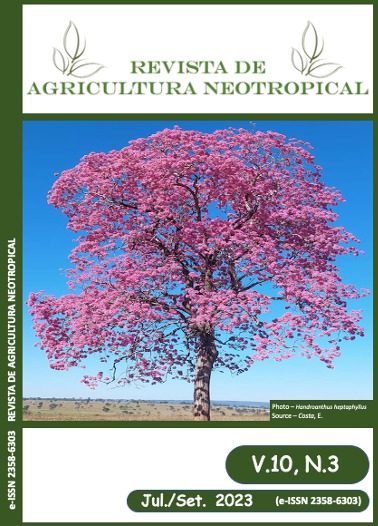DOES LIGHT SUPPLEMENTATION IMPROVE THE INITIAL GROWTH OF HOPS SEEDLINGS IN A PROTECTED ENVIRONMENT?
Visualizações: 423DOI:
https://doi.org/10.32404/rean.v10i3.7401Keywords:
Humulus lupulus L.,, Indoor cultivation, Photosynthetic activity, CarboxylationAbstract
The hops (Humulus lupulus L.) has significant importance for Brazil since its consumption in the manufacture of beer is primordial, although the country imports almost 100% of the hops consumed. Research in this area has increased recently, bringing new information and guidelines to support national production and provide a technical basis for improving planting and cultivation techniques. The present study aimed to evaluate the influence of different light supplementations (Control - environmental condition, 400 µmol m-2 s-1, 600 µmol-2 m s-1, and 800 µmol m-2 s-1 ) on the production of hops seedlings in a greenhouse. We found that the responses are distinct among the cultivars used, but light supplementation increases variables related to physiological processes and seedling growth. Thus, we conclude that light supplementation with photosynthetically active radiation is advantageous for the production of hops seedlings since positive effects were found on the physiological characteristics of gas exchange related to photosynthesis and plant development when 400, 600, and 800 µmol m-2 s-1 were applied. In addition, the intrinsic responses of each cultivar should be observed to adapt the production system.
References
(I) Agehara, S.. 2020. Using Supplemental Lighting to Control Flowering of Hops in Florida: HS1365, 4/2020. EDIS, 2020(2). University of Florida, Gainesville.
(II) Agehara, S, Gallardo, M., 2021. Uso de Iluminación Suplementaria para Controlar Floración de Lúpulos en Florida: HS1415/HS1365s, 5/2021. EDIS, 2021(3). University of Florida, Gainesville.
(III) Bauerle, W.L., 2021. Internode elongation and strobili production of Humulus lupulus cultivars in response to local strain sensing. Scientific Reports, 11(1), 1-10. DOI: https://doi.org/10.1038/s41598-021-88720-8
(IV) Craig, D.S., Runkle, E.S., 2013. A moderate to high red to far-red light ratio from light-emitting diodes controls flowering of short-day plants. Journal of the American Society for Horticultural Science, 138(3), 167-172. DOI: https://doi.org/10.21273/JASHS.138.3.167
(V) Christiaens, A, Gobin, B, Van Huylenbroeck, J, Van Labeke, M.C. 2019. Adventitious rooting of Chrysanthemum is stimulated by a low red: far-red ratio. Journal of plant physiology, 236, 117-123. DOI: https://doi.org/10.1016/j.jplph.2019.03.008
(VI) Easlon, HM, Bloom, A.J. 2014. Easy Leaf Area: Automated digital image analysis for rapid and accurate measurement of leaf area. Applications in plant sciences, 2(7), 1400033. DOI: https://doi.org/10.3732/apps.1400033
(VII) Eichhorn Bilodeau, S, Wu, BS, Rufyikiri, AS, MacPherson, S, Lefsrud, M., 2019. An update on plantphotobiology and implications for cannabis production. Frontiers in plant science, 10, 1-15. DOI: https://doi.org/10.3389/fpls.2019.00296
(VIII) Fagherazzi, M.M, Rufato, L., 2018. Producing hops in Brazil, utopia or reality. Revista Agronomia Brasileira, 2(1), 1-2.
(IX) Gloser, V, Balaz, M, Jupa, R, Korovetska, H, Svoboda, P., 2013. The response of Humulus lupulus to drought: the contribution of structural and functional plant traits. Acta Hortic, 1010, 149-154. DOI: https://doi.org/10.17660/ActaHortic.2013.1010.17
(X) Hawley, D., Graham, T., Stasiak, M., Dixon, M., 2018 Improving cannabis bud quality and yield with subcanopy lighting. HortScience, 53(11), 1593-1599. DOI: https://doi.org/10.21273/HORTSCI13173-18
(XI) Jastrombek, JM, Faguerazzi, MM, de Cássio Pierezan, H, Rufato, L, Sato, AJ, da Silva Ricce,W, Marques, VV, Leles, NR, Roberto, SR., 2022. Hops: an emerging crop in subtropical areas in Brazil. Horticulturae, 8(5), 393. DOI: https://doi.org/10.3390/horticulturae8050393
(XII) Korpelainen, H, Pietiläinen, M. 2021. Hop (Humulus lupulus L.): Traditional and present use, and future potential. Economic botany, 75(3-4), 302-322. DOI: https://doi.org/10.1007/s12231-021-09528-1
(XIII) Litvin, AG, Currey, CJ, Wilson, LA., 2020. Effects of supplemental light source on basil, dill, and parsley growth, morphology, aroma, and flavor. Journal of the American Society for Horticultural Science, 145(1), 18-29. DOI: https://doi.org/10.21273/JASHS04746-19
(XIV) Morrow, R.C., 2008. LED lighting in horticulture. HortScience, 43(7), 1947-1950. DOI: https://doi.org/10.21273/HORTSCI.43.7.1947
(XV) Nguyen, C.D., Nguyen, C.D., Vu, D., Huo, H., Pearson, B., 2020. LED light increases leaf area and root length of Humulus lupulus (var. Tettnanger) In Vitro: ENH1319/EP583, 8/2020. EDIS, 2020(4). University of Florida, Gainesville.
(XVI) Pan, T., Wang, Y., Wang, L., Ding, J., Cao, Y., Qin, G., Yan, L., Xi, L., Zou, Z. 2020. Increased CO2 and light intensity regulate growth and leaf gas exchange in tomato. Physiologia plantarum, 168(3), 694-708. DOI: https://doi.org/10.1111/ppl.13015
(XVII) Rocha, M.E.L., Coutinho, P.W.R., Abade, M.T.R., Inagaki, A.M., Cadorin, D.A., Hoepers, L.M.L. 2019. Morphophysiology of butter cabbage plants under liquid humus concentrations. Revista de Ciências Agroveterinárias, 18(4), 438-443. DOI: https://doi.org/10.5965/223811711842019438
(XVIII) Taiz, L., Zeiger, E., Moller, I.M., Murphy, A. 2017. Plant Physiology and Development, sixth ed. Sinauer Associates, Sunderland.
Tavares, P.L., Guimarães, I.A.B., Braga, H.A.C., Bender, V.C., Almeida, P.S. 2017. LED system with independent red and blue channels employing radiant flux estimation and indirect flux control for greenhouse hop cultivation. Brazilian Conference on Power Electronics, Juiz de Fora. pp. 1-9. DOI: https://doi.org/10.1109/COBEP.2017.8257403
Downloads
Published
How to Cite
Issue
Section
License

This work is licensed under a Creative Commons Attribution 4.0 International License.
The authors retain the rights to the manuscripts and, therefore, are free to share, copy, distribute, perform and publicly communicate the work under the following conditions:
Acknowledge work credits in the manner specified by the author or licensor (but not in a way that suggests that you have their support or that they support their use of their work).
REVISTA DE AGRICULTURA NEOTROPICAL (ISSN 2358-6303) is under license https://creativecommons.org/licenses/by/4.0/
The State University of Mato Grosso do Sul, Sustainable Development Center of Bolsão Sul-Mato-grossense (CEDESU), of the University Unit of Cassilândia (UUC), preserves the patrimonial rights (copyright) of the published works and favors and allows their reuse under the license as mentioned above.
------------
The journal reserves the right to make normative, orthographic, and grammatical alterations in the originals, to maintain the cult standard of the language, respecting, however, the style of the authors.
Final proofs will be sent to the authors.
Published works become the property of the journal. The opinions expressed by the authors of the manuscripts are their sole responsibility.
